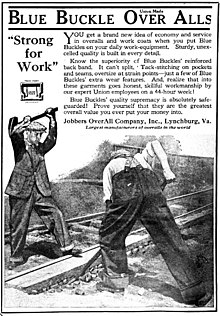Workwear
[5] In Britain from the mid 19th century until the 1970s, dustmen, coalmen, and the manual laborers known as navvies wore flat caps,[6] corduroy pants, heavy boots,[7] and donkey jackets,[8] often with a brightly colored cotton neckerchief to soak up the sweat.
Since the late 18th century, merchant seamen and dockworkers have worn denim flared trousers, striped undershirts, knitted roll neck jumpers, and short blue peacoats.
[citation needed] In wet weather, sailors wore oilskins and Souwesters, but contemporary fishermen generally wear a two piece yellow or orange waterproof jacket and trousers.
In the Old West era, Union Pacific train engineers and railroad workers wore distinctive overalls, caps and work jackets made from hickory stripe[13] before boiler suits were invented in the early 20th century.
[14][15] Railway conductors, porters and station masters wore more formal blue uniforms based on the three piece lounge suit, with brass buttons and a military surplus kepi from the Civil War era.
[16] Since the days of the Old West, American and Canadian lumberjacks have worn buffalo plaid Pendleton jackets, wool tuques, trapper hats, tall waterproof boots with a reinforced toecap, and chaps as protection from the chainsaw.





